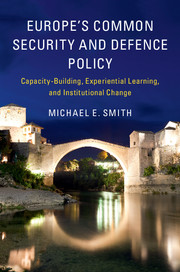 Europe's Common Security and Defence Policy
Europe's Common Security and Defence Policy Book contents
- Europe’s Common Security and Defence Policy
- Europe’s Common Security and Defence Policy
- Copyright page
- Dedication
- Contents
- Tables
- Acknowledgements
- Abbreviations
- Introduction
- 1 Experiential Institutional Learning and the CSDP
- 2 The First CSDP Actions: Taking Over from the UN and NATO in the Balkans
- 3 Independent Military Peacekeeping Operations
- 4 Civilian Police and Monitoring Missions
- 5 Rule of Law and Security Sector Reform Missions
- 6 The EU as a Maritime Actor: EUNAVFOR Somalia
- 7 The CSDP and the Comprehensive Approach under the Lisbon Treaty
- 8 Security, Strategy, and the EU’s Global Role
- Bibliography
- Index
- References
Bibliography
Published online by Cambridge University Press: 05 July 2017
- Europe’s Common Security and Defence Policy
- Europe’s Common Security and Defence Policy
- Copyright page
- Dedication
- Contents
- Tables
- Acknowledgements
- Abbreviations
- Introduction
- 1 Experiential Institutional Learning and the CSDP
- 2 The First CSDP Actions: Taking Over from the UN and NATO in the Balkans
- 3 Independent Military Peacekeeping Operations
- 4 Civilian Police and Monitoring Missions
- 5 Rule of Law and Security Sector Reform Missions
- 6 The EU as a Maritime Actor: EUNAVFOR Somalia
- 7 The CSDP and the Comprehensive Approach under the Lisbon Treaty
- 8 Security, Strategy, and the EU’s Global Role
- Bibliography
- Index
- References
- Type
- Chapter
- Information
- Europe's Common Security and Defence PolicyCapacity-Building, Experiential Learning, and Institutional Change, pp. 305 - 321Publisher: Cambridge University PressPrint publication year: 2017


